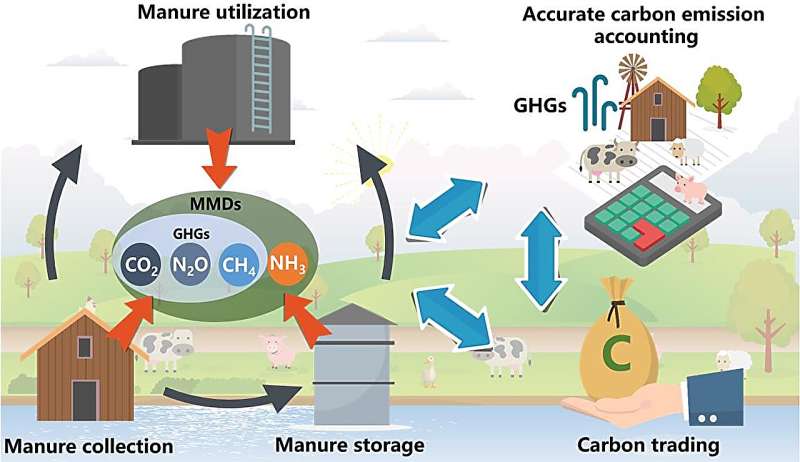This article has been reviewed according to Science X's editorial process and policies. Editors have highlighted the following attributes while ensuring the content's credibility:
fact-checked
proofread
Livestock manure management from the perspective of carbon neutrality in China

Global population growth, socioeconomic development and improved living standards have led to surging demand for livestock and poultry products such as meat, eggs and milk. Consequently, it stimulated the rapid development of livestock and poultry industry and aggravated the environmental problems such as the greenhouse effect.
Animal husbandry in China has had significant growth over the past 50 years, with a 13.3% increase in total output value. This expansion has resulted in the production of an enormous amount of livestock and poultry manure, totaling up to 3.8 Gt annually. CH4 and N2O, which have GWP (global warming potential) of 23 and 298 times greater than CO2, are the main GHGs (greenhouse gases) from livestock and poultry production. Thus, livestock and poultry manure management system has become one of the main sources of agricultural carbon emissions.
The United Nations issued the 2030 Agenda for sustainable development, which encourages countries to adopt sustainable production practices, conduct scientific research, and employ appropriate technologies as well as management methods to reduce the GHG emission potential of livestock and poultry production by 30%. The key to achieving this goal is to reduce carbon emission intensity and renewable energy credits.
The theoretical basis for reducing carbon and other pollutant emissions from the livestock and poultry production include accounting methods for the carbon emissions and carbon footprint, determining the influencing factors and mechanisms of carbon emission, and gradually forming the methodology of carbon emission reduction. Fossil energy consumption in people's everyday life could be reduced or replaced by increasing the bioenergy generated from livestock and poultry manure.
From the perspective of carbon neutrality strategy, Professor Zhidan Liu from China Agricultural University and his colleagues focused on the manure management system of livestock and poultry, sorted out the emission status of greenhouse gases and other harmful gases at the stage of manure collection, storage and treatment, and qualitatively analyzed the carbon friendliness of various manure management technologies.
Distinguished from previous reviews focusing on resource recovery and technology on manure treatment, this work, now published in Frontiers of Agricultural Science and Engineering delved deeper into the concept of coordinated pollution reduction and carbon reduction, moving beyond the resource-oriented treatment approach. Meanwhile, the technologies for livestock and poultry manure management were highlighted in a way that coordinates the pollution and carbon reduction objectives.
In addition, the influencing factors and mechanisms of manure carbon emission were summarized. Finally, the status and potential development of the carbon trading system were analyzed and as well as suggestions and potential countermeasures for livestock and poultry manure pollution reduction were put forward.
Three stages collection, storage and treatment were involved in livestock and poultry manure management system. The use of dry collection technology at the collection stage is highly recommended, and acidification, compaction, mulching, addition of regulators, such as biochar, and storage tanks help reduce GHG emission during storage stage. Technologies in the waste treatment stage have advantages and disadvantages in terms of principle, carbon friendliness and technical maturity.
For open systems, such as composting, achieving source reduction of harmful gases remains to be studied. Although anaerobic digestion technology is environmentally friendly, the problems of high investment cost and low efficiency of low-temperature CH4 production constrain its adoption. Biochar and microalgae technologies clearly have the great potential for carbon emission reduction, but more detailed technical and economic evaluation is required.
The amount of GHG emission from livestock and poultry manure management system depends on many factors, including regional distribution, temperature and season, the feature (like type, age, weight, sex, health status, physiological cycle) of livestock and poultry, manure treatment details, characteristics of feed for livestock, and social factors like economy, policy and population. In order to determine the influence degree of each factor, it is necessary to conduct factor decomposition research.
Carbon emission and carbon footprint accounting methods, such as mass balance method, actual measurement method, carbon emission factor method (OECD, IPCC), input-output method, life cycle assessment methods are used in different situations according to their different advantages and disadvantages. Some subjective and objective reasons often lead to the uncertainty of accounting results, the application of Monte Carlo simulation after carbon emission accounting can help reduce the uncertainty of accounting results.
As a market-oriented energy saving mechanism carbon trading is promising. China's carbon market started relatively late but has been growing fast. The carbon trading market of livestock and poultry manure management system has broad potential for development. Efforts in manure treatment technology, methodology, trading mechanism, farming method, economy, politics, dietary structure and other aspects will bring about a good carbon trading mechanism, thus assisting carbon neutrality to be realized as soon as possible.
More information: Livestock and Poultry Manure Management from the Perspective of Carbon Neutrality in China, Frontiers of Agricultural Science and Engineering (2023). DOI: 10.15302/J-FASE-2023509
Provided by Frontiers Journals





















